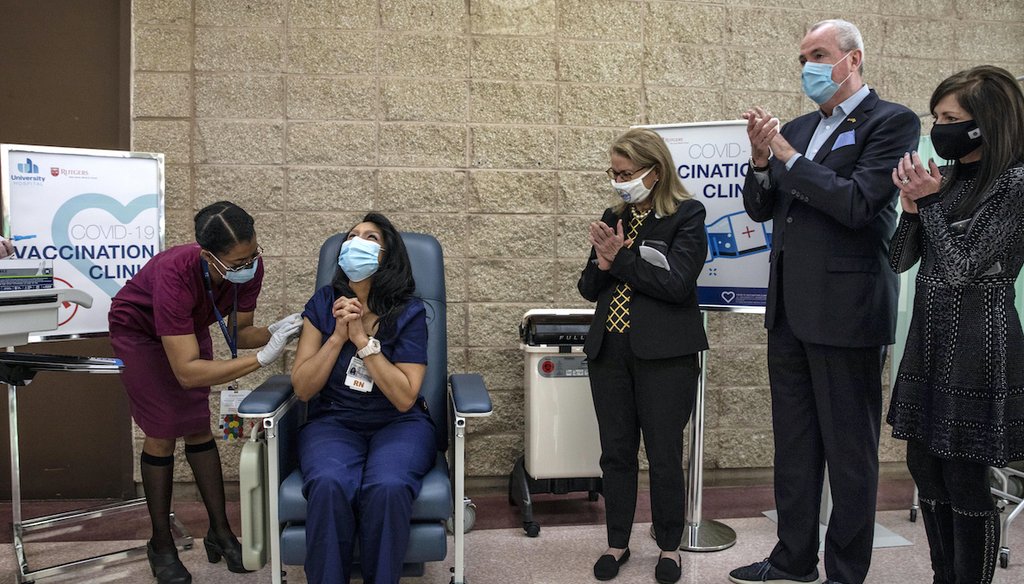Get PolitiFact in your inbox.

New Jersey Gov. Phil Murphy, second from right, watches as nurse Maritza Beniquez, seated, reacts after being the first in the state to receive the Pfizer-BioNTech COVID-19 vaccine, at University Hospital, in Newark, NJ, Tuesday Dec. 15, 2020. (AP)
If Your Time is short
-
Experts stress the need to rely on facts and data when confronted with claims that stoke fear about the vaccine.
-
The vaccine is not a single silver bullet — we will still need to wear masks, wash hands and social distance to reduce the spread for some time.
Health care workers across the country on Dec. 14 became the first Americans to get the vaccine following trials, kicking off the country’s most ambitious effort ever to vaccinate hundreds of millions of Americans.
In every state in the nation, journalists were watching the process and asking questions.
The Poynter Institute and the American Medical Association held a seminar to connect journalists with top vaccination experts. Hosted by Poynter senior faculty Al Tompkins, experts offered tips about how to cover the vaccine and answered questions about the science behind the inoculation.
The experts included Dr. Susan Bailey, president of the American Medical Association; Dr. Leon McDougle, president of the National Medical Association; Dr. Paul Offit, director of The Vaccine Education Center at Children’s Hospital of Philadelphia; and Patricia A. Stinchfield, a pediatric nurse practitioner and president-elect of The National Foundation for Infectious Diseases.
Along with medical experts and community leaders, journalists will play an important role in educating the public about the vaccines. Here are some takeaways for journalists that we gleaned.
Communicating vaccine facts
Choose your photos to educate and be careful not to reinforce people’s fears.
Some people are afraid of needles, and yet journalists often use photos of needles being injected into people. "There are a lot of photos of families after vaccination smiling and working with clinicians," Stinchfield said.
Put vaccine data into historical perspective.
While vaccine hesitancy is a concern, journalists can turn to historical data about vaccination rates to put it into perspective. The majority of parents vaccinate their children on schedule by the time they enter kindergarten while about 1-2% are the "very loud anti-vaccine group," Stinchfield said. For the remainder who are vaccine hesitant, provide scientific facts and explain that experts are constantly monitoring vaccines. "That should give people comfort," Stinchfield said.
PolitiFact found that most polls have found between 50% and 70% of Americans willing to get vaccinated for COVID-19, which is not as high as epidemiologists would like to see if a vaccine is to fully eradicate the coronavirus but is likely get higher as people become more educated and comfort levels improve.
Look for ways to cover distribution equity and outreach, especially in Black and indigenous communities that have been hardest hit by COVID-19.
McDougle, president of the National Medical Association, said his biggest concerns are the equitable distribution of the vaccine and what appears to be a reluctance to take it among individuals from among lower-income and communities of color.
To expand outreach, he said that Black leaders have pulled together all of the pillars of society — professional organizations, colleges, churches — to address and inform community members that the vaccine is safe.
"Involve Black people in the process," McDougle added. "When you have people of color integrated in the oversight and even production (of the vaccine) ... seeing that involvement directly is also something that can give confidence."
Share what experts know based on available evidence and facts at the time.
Doctors and experts don’t over promise or over state what is known and explain that we are still learning about COVID-19 and monitoring the vaccines. "As journalists, your job is to do the same," Stinchfield said. The mild to moderate risks of the vaccine carry far less of an impact than the serious effects of the virus, which can include long-term health issues or even death.
"Make sure you're talking to the right experts and look for creative ways, visual infographics, videos, analogies, that are going to get at all age groups and ethnicities so that we can understand this complexity," she said.
Inform the public that the vaccine is safe and effective.
Journalists should review the evidence and inform readers about the rigorous review process required before it could be approved for public use.
Let people know that it’s not abnormal for the vaccine to make them feel crummy a day or two after taking it. This is common among vaccines.
"If you have some sort of reaction, that means the shot is actually working," Stinchfield said. "Your immune system is responding. It sees the bad guy and it’s making the good guys. It’s a small, one to two day sense of illness and it is far, far better than having COVID disease."
The vaccine isn’t a silver bullet, and a safe return to "normal life" may take a while. There’s still not enough data to indicate whether someone could still spread the virus, asymptomatically, after getting vaccinated.
"At first you do need to keep wearing a mask and social distancing and washing your hands," said Bailey, the American Medical Association president. "The verdict is still out on whether or not you can transmit the virus if you've had the vaccine. To really contain the virus it’s important to continue practicing these important public health measures. … It’s risky to assume once you get the shot in the arm that you can live life as normal."
Use plain language to simply explain scientific terms.
For example, the term "efficacy" describes how well the vaccine is working in those controlled clinical trials, while "effectiveness" is how well it’s working from this point forward, as it is rolled out to the general population.
What we know — and don’t know — about the vaccine and COVID-19
The group addressed common questions about the science behind the lead vaccine candidates but stressed there’s not a lot of definitive answers at this early stage.
It’s possible that the virus could mutate like the flu, requiring a new vaccine every year, but we don’t know.
Offit, of Children’s Hospital of Philadelphia, said that he believes vaccine immunity from COVID-19 will last years, but not necessarily decades.
Still, it is a single-strand RNA virus, like measles, mumps and influenza, he said, so the question remains which one it will act like.
"(Will it behave) like influenza, which changes too much in a year, thus requiring a new vaccine each year?" Offit posited. "Or is it going to be like measles, which mutates but not rapidly."
Vaccinations are still recommended for people who have had COVID-19.
Medical researchers and immunology experts say it’s rare, but possible, for recovered COVID-19 patients to become infected with the virus again as their natural antibody levels wane over time. The vaccine is expected to provide stronger and likely longer-lasting immunity.
In its recently released vaccine recommendations, the Centers for Disease Control and Prevention said that vaccination should be offered regardless of history of prior symptomatic or asymptomatic SARS-CoV-2 infection, with clinical trial data indicating it is safe and likely efficacious.
Our Sources
See links in story











































